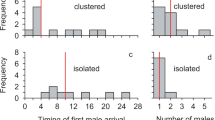Summary
Small male milkweed beetles are less successful at obtaining mates than are larger males. Larger males usually win fights and prevent smaller males from obtaining mates and from choosing larger more fecund females as mates. When sex ratios are male-biased, smaller males are particularly likely to experience these mating disadvantages. It follows that smaller males should be especially responsive to their local competitive environment and behave so as to minimize the mating disadvantages of their smaller size. This paper tests the hypothesis that smaller males disperse from host plant patches with male-biased sex ratios and remain in patches with female-biased sex ratios more readily than larger males.
Results show both larger and smaller males disperse from patches with male-biased sex ratios more frequently than from patches with femalebiased sex ratios. As predicted, however, small males are more likely to disperse from patches with male-biased sex ratios and remain in patches with female-biased sex ratios than are larger males.
The data also show that smaller males dispersing from patches with male-biased sex ratios obtain more matings than non-dispersing males.
For milkweed beetles, moving between patches can be viewed as an alternative mating tactic conditional on male body size and local sex ratio.
Similar content being viewed by others
References
Alcock J, Jones CE, Buckmann SL (1977) Male mating strategies in the bee Centris pallida Fox (Hymenoptera: Anthophoridae). Am Nat 111:145–155
Cade W (1980) Alternative male reproductive behaviors. Fla Ent 63:30–45
Caro TM, Bateson P (1986) Organization and ontogeny of alternative tactics. Anim Behav 34:1483–1499
Davis MA (1984) The flight and migration ecology of the red milkweed beetle Tetraopes tetraophthalmus. Ecology 65:230–234
Dawkins R (1980) Good strategy or evolutionarily stable strategy? In Barlow GW, Silverberg J (eds) Sociobiology: beyond nature/nurture. Westview Press, Boulder, Col, pp 331–361
Dominey W (1984) Alternative mating tactics and evolutionarily stable strategies. Am Zool 24:385–396
Johnson LK (1982) Sexual selection in a tropical brentid weevil. Evolution 36:251–262
Johnson LK, Hubbell SP (1984) Male choice: experimental demonstration in a brentid weevil. Behav Ecol Sociobiol 15:183–188
Lawrence WS (1986a) Male choice and competition in Tetraopes tetraophthalmus: effects of local sex ratio variation. Behav Ecol Sociobiol 18:289–296
Lawrence WS (1986b) Movement ecology of the red milkweed beetle Tetraopes tetraophthalmus (Forster). Ph D Thesis, Yale University, New Haven, Conn
Lawrence WS (1987a) Effects of sex ratio on milkweed beetle emigration from host plant patches. Ecology 68:539–546
Lawrence WS (1987b) The movement ecology of the red milkweed beetle in relation to population size and structure. J Anim Ecol (in press)
Mason LG (1964) Stabilizing selection for mating fitness in populations of Tetraopes. Evolution 18:492–497
McCauley D (1979) Geographic variation in body size and its relation to the mating structure of Tetraopes populations. Heredity 42:143–148
McCauley D (1982) The behavioral components of sexual selection in the milkweed beetle Tetraopes tetraophthalmus. Anim Behav 30:23–28
O'Neill KM, Evans HE (1983) Alternative male mating tactics in Bembecinus quinquespinosus (Hymenoptera: Sphecidae): correlations with size and color variation. Behav Ecol Sociobiol 14:39–46
Parker GA, Sutherland WJ (1986) Ideal free distributions when individuals differ in competitive ability: phenotype-limited ideal free models. Anim Behav 34:1222–1242
Price PW, Willson MF (1976) Some consequences for a parasitic herbivore, the milkweed longhorn beetle, Tetraopes tetraophthalmus of a host-plant shift from Asclepias syriaca to A. verticillata. Oecologia (Berlin) 25:331–340
Shapiro A (1970) The role of sexual behavior in density-related dispersal of Pierid butterflies. Am Nat 104:367–372
Sokal RR, Rohlf FJ (1981) Biometry. Freeman, San Francisco
Solbreck C (1978) Migration, diapause and direct development as alternative life histories in a seed bug, Neacoryphus bicrucis. In Dingle H (ed). Evolution of insect migration and diapause. Springer, Berlin Heidelberg New York, pp 195–217
Southwood TRE (1977) Habitat, the templet for ecological strategies. J Anim Ecol 46:337–365
Author information
Authors and Affiliations
Rights and permissions
About this article
Cite this article
Lawrence, W.S. Dispersal: an alternative mating tactic conditional on sex ratio and body size. Behav Ecol Sociobiol 21, 367–373 (1987). https://doi.org/10.1007/BF00299931
Received:
Accepted:
Issue Date:
DOI: https://doi.org/10.1007/BF00299931




